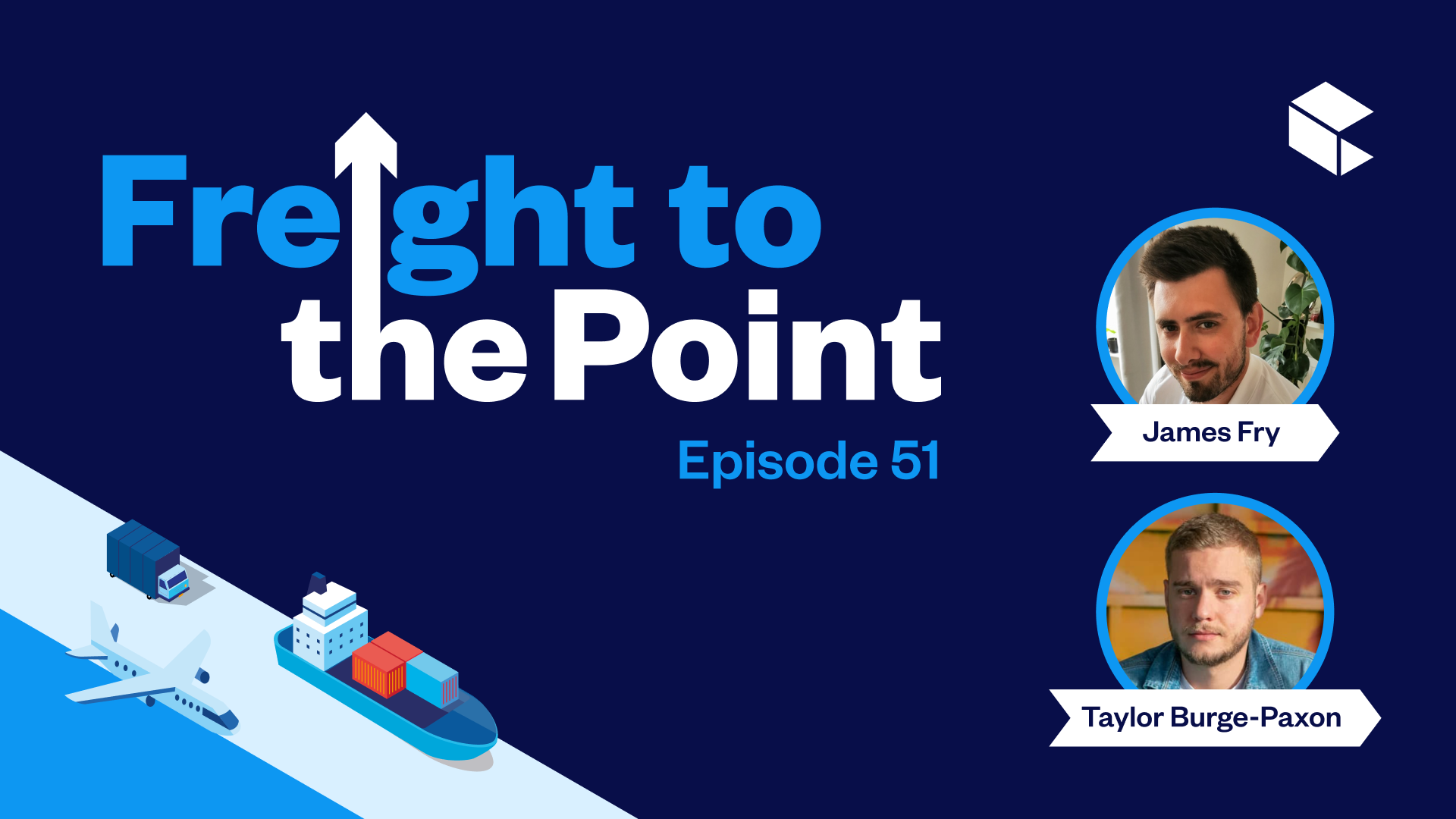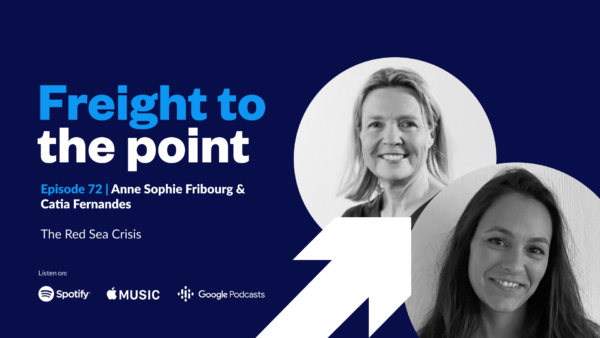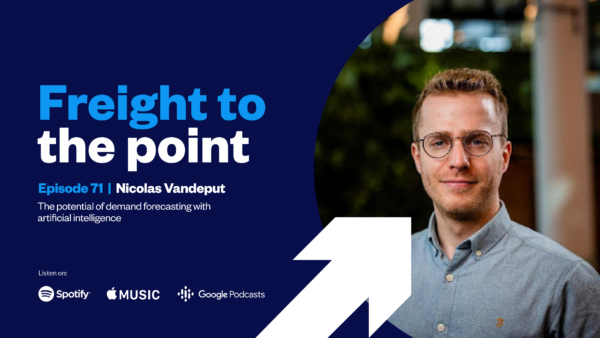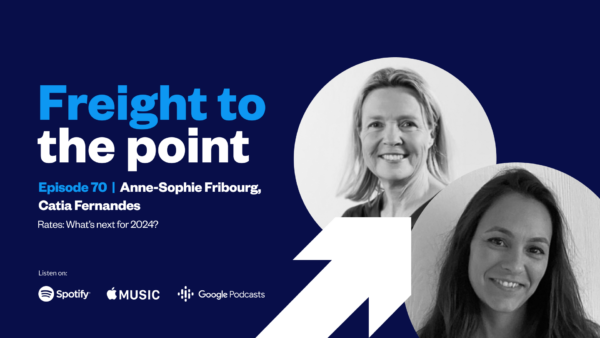Episode 51:
How a great forwarder offers more than just great rates
See all episodes

“Shippers are now shifting their focus from transactional price focused relationships and are more so looking for long term freight forwarding partners that align with their strategic business objectives”
Disruptions have become the norm and shippers are no longer seeing the value of having a freight forwarder that just moves goods from A to B.
They want a partner that improves efficiencies in their supply chain, provides solutions and will go above and beyond the day-to-day operations.
Tune into the latest episode of Freight to the Point as James Fry, Director of Solutions at Zencargo, is joined by Taylor Burge-Paxon, Senior Customer Success Manager at Zencargo to talk about the benefits of a true partnership with a digital freight forwarder.
They talk about:
- The risks of a transactional relationship
- The factors driving the change in relationship between shipper and freight forwarder
- How can shippers identify what a great freight forwarder looks like
James Fry
James is Zencargo’s Director of Solutions and has worked in supply chain for over 10 years. James leads a team of experts who work with Zencargo customers to identify areas of opportunity and build bespoke solutions to deliver value. James and his team focus on optimising costs and ultimately driving supply chain performance for customers.
Taylor Burge Paxon
Taylor Burge-Paxon is a Senior Customer Success Manager at Zencargo and works with brands in the retail sector to maximise supply chain opportunities. Prior to Zencargo, Taylor also worked for CH Robinson, a multimodal transportation services and third-party logistics company managing high growth accounts especially in the food and beverage sector.
Resources
Measuring a freight forwarder’s value
What should shippers expect from a modern freight forwarding service?
Welcome to another episode of Freight to the Point. I’m James Fry, Director of Solutions here at Zencargo and today I am joined by the one and only Taylor Burge-Paxon, senior customer success manager here at Zencargo as well. So, in regards to a little bit of context before we kick off, before Taylor introduces himself, so as everyone is aware, supply chains have been changing a lot over the pandemic and since the pandemic. And as a summary we really saw consumer demands skyrocket over the past couple of years, however, with the combination of the unfortunate scenarios and situations of the Ukraine and Russia war and the soaring energy prices, we’ve seen consumer spending confidence really go down over the past 18 months or so. So, as a result of that then, from the many retailers that have been hit hard with that reduced consumer spending and we’ve been hearing that businesses have really been less likely to make changes in their supply chain as they believe it holds more risk now. So, in today’s episode, Taylor and I are going to be talking about what potential change can bring, especially when choosing the right partner who works with you to get the most out of your supply chain. So, hey Taylor. Welcome to the podcast.
Taylor Burge-Paxon:
Hey, James. Thanks for having me.
James Fry:
Pleasure. Okay, let’s dive right in. So I suppose freight forwarder relationships have traditionally been fairly transactional and so this first question to you Taylor is, what do you think the risks are to having this more transactional relationship?
Taylor Burge-Paxon:
Yeah, I think when shippers have relationships that are purely transactional and only focused on price, it really treats transportation services as a homogenous commodity and it overlooks some very impact value add services that a strategic freight forwarding partner can provide. So that can be things like improve service level through shortened dwell times and shorter overall lead times, things like identifying consolidation opportunities to cut down on cost, selecting optimize modes of transport, specific routeing, carrier selection models, that better balance cost and service level needs. And of course, on the technology point of view, when you’re not strategically aligning with your freight forwarding partner around technical integrations, there are a lot of missed opportunities to automate processes, reduce internal work loads, really improve visibility, and overall make the lives of your internal cross functional teams much, much easier.
James Fry:
Yeah, no exactly. And I think there probably was a time and a place where that more transactional relationship worked and it was the best approach. But definitely over the past few years we’ve seen lots of new factors now, which are really driving a change in that relationship and making it some of the things that we’re going to discuss, not now, could’ve been nice to have from of the relationship from the freight forwarder, but now are a must have. From your experience, what are some of the factors then that have been driving the changes in these freight forwarder and shipper relationships?
Taylor Burge-Paxon:
Yeah, so as you mentioned COVID, obviously during COVID supply chain bottlenecks, things like the Suez Canal blockage, the Yantian Port crisis, the unprecedented congestion on the US West Coast and in EU ports, all of these things disrupted the flows of goods worldwide. These bottlenecks and the skyrocketing demand caused freight rates to soar, which really put supply chain management front and center as companies grappled with higher freight costs, making up a much larger portion of their cost of goods sold, or their landed cost, whatever metric that they use internally. So, while service reliability from carriers was down across the port, lead times were extended, many shippers were purely focused on procuring whatever space they could get their hands on for the lowest possible price.
James Fry:
Definitely agree with all those points. So now that COVID has, say subsided, how are things changed?
Taylor Burge-Paxon:
So as we come out of the pandemic there are new economic forces at play. Things that you mentioned earlier, high inflation, soaring energy costs that are driving down consumer demand in a time when companies have built up a very large surplus of stock from their buying boom during COVID, so as a result freight rates have dropped to near pandemic levels on most major trade lanes. Carriers are now implementing very aggressive blank sailing programs to try to balance that over supply or that over capacity in the market, which causes issues for shippers who are on particularly tight timelines and require shorter lead times. So what I’ve seen is that shippers are now shifting their focus from those more transactional price focus relationships and are more so looking for long term freight forwarding partners that align with their strategic business objectives and are aiming to build a more resilient supply chain overall. They’re looking for partners that are collaborative and lead in identifying continuous improvement opportunities and really drive efficiency and long term cost savings.
James Fry:
Great, yeah. And this leads onto my next question which is around what key services that shippers should be looking for. And I suppose I can add a little bit of colour to this from my experience here at Zencargo. So, I’d say within the solutions team here at Zen, we’re working across the entire customer journey, right? From when we’re having initial conversations with our customers all the way through when we’re working day in and day out with our customers. Definitely over the COVID period where those freight rates were skyrocketing into the levels that they were, when we were trying to identify and unlock where the RY was. It was obviously a much smaller percentage against cost of the freight which they were paying, which made it more of a difficult conversation, I suppose, or more of a difficult decision when you’re having to pay such a large amount on your freight rates and the potential savings are only small relative to that. But obviously now we’ve shifted, as you mentioned, now we’re pre-pandemic and a normalized freight rate situation in the areas of value and ROI we can unlock and that was a significant proportion against freight spent.
Again, using the phrase I mentioned earlier, it’s nice to have as much more of must have now and you have to leave a lot of money sat on the table. And going back to how we look for those areas of RY here at Zen, and as I mentioned, we said across the entire customer journey, so right form initial conversations through to then when we’re working, trying to understand if there’s an opportunity to our customers. We spend a lot of time doing process mapping workshops. We call it as-is mapping, going through from purchase order age all the way through to delivery at the destination warehouse. Across that journey we’re looking to capture pinpoints and opportunities, we’re looking at data to start crunching the numbers to be able to calculate and quantify what the potential ROI is, and really most importantly, in our approach here at Zen, all of our customers go through that same process with us. So no matter if it’s one container, a hundred, or a thousand, or ten thousand TEUs that a customer is potentially going to be moving with us, we go through that same exercise because there are still similar opportunities that can be driven from a customer supply chain regardless of the volume, maybe just the ROI is just a little bit smaller.
So yes, we’re doing that, just not only in the initial conversation, but most importantly when the solutions team, the Zen team member will work with that customer across the entire journey. So even when we’re implementing the customers, the solutions team member is there making sure that the opportunities that we captured are being implemented all the way through to working with yourself and the rest of the team, we’re proactively looking for where we can drive more value from our customer supply chains and that’s from what I describe more of a tactical basis than using the data that we’re capturing on a monthly cadence to be able to identify potential pockets of value that we can drive. But then that’s all the way kind of up and more corporate objective level to then really holistically trying to understand how the supply chain is going to enable customers businesses to be able to grow and hear any kind of strategies or initiatives that they have in place. So we sit across that whole spectrum providing consultative services.
So, I suppose come to the question that mentioned, what should shippers be looking for? I think that element is definitely what are now currently everyone should be looking for from their freight forwarding relationship is to be able to help my freight forwarder help me unlock value, drive forward our supply chain, and make our supply chain essentially a businesses competitive advantage. But it’d be good to understand from you, Taylor, what key services shippers should be on the lookout for?
Taylor Burge-Paxon:
Yeah. I think there’s a number of examples on how we drive value and you touched on it. There’s a lot of things on a day to day basis that I work really hand in hand with, with yourself and the solutions team to push forward value with customers, things like just selecting sailings and carrier options that offer pre-carriage or on-carriage cost savings, and that’s really done by capitalizing on one wage range from inland container depots instead of two-way journeys all the way from port to delivery. So that’s a day to day tactical one that’s good at really realizing some real cost savings, running cost comparisons between trans-loading and drayage options at destination to avoid any container restitution bottlenecks, conducting consolidation analyses to determine optimal solutions between CFS or milk runs and determining if there’s a critical mass of volume to justify a consolidation opportunity without unnecessarily extending lead times. That’s probably one, James, that you get very intimately involved in.
Some other ones, coordinating with suppliers and reporting back on their performance to customers related to changes in cargo readiness dates and how well individual suppliers are stuffing containers at origin, providing centre of gravity analysis. Again, James, this is one where I tend to loop in the solutions team and we work hand in hand really advising our customers on where best to place their DC’s based on where their final customers are. We tend to put forward 3PL and DC partners that are best aligned with, with E-Commerce and storage requirements. And we, a lot recently with limited space and warehouses, were providing temporary overflow facilities for customers who are low on storage space at their current DC’s.
We do a lot of stuff with direct Amazon routing, putting in place solid operational processes to best navigate that, really the world of Amazon requirements. And then when customers are getting involved in new trade lanes, we help identify direct routeings, navigate customs, nuances, pick services that really just best align with their specific needs and then of course we can manage any direct carrier contracts on our customer’s behalf, and really build out a much broader control tower solutions, multi-forward our visibility, that allows them to apply inset and offset carbon credits across their entire transportation network across multiple forwarders. So a lot of really cool tools there to drive value and cut down on cost.
James Fry:
Yeah, absolutely. And I think all those things that you touched on there ties back into what I mentioned, that reusing all the great data that we’re capturing daily to be able to, at a tactical level, really understand how we can drive value through better routeings, better services, food consolidation, better modal choices. But also through working with yourselves and the solutions team, we’re able to go much, much further, really go into those strategic initiatives such as centre of gravity analysis, cost of serve, got a flow analysis, and things like that. And I think that’s really a testament to the structure and the functions that we’ve been able to develop here at Zencargo to really be customer first. Cool, okay. So leading onto the next question then, how do you or how can shippers and freight forwarders work together more effectively through their relationship then?
Taylor Burge-Paxon:
It is a good question. I think a strong onboarding process is really key in order to align on priorities, and timelines and really lay a solid foundation for the rest of the relationship where expectations are aligned on and executed on. In terms of really the secret ingredient to effective relationships, I think it’s all about collaboration. There’s no real substitute for having a freight forwarding partner that essentially services as an extension of your business. When your freight forwarder has a full picture of how your supply chain operates and what your companies goals are, we can align and help to identify opportunities to drive change to those strategic desired outcomes. As you mentioned before, one of the best tools in our arsenal to do that is to kickstart things with that as-is, to-be supply chain mapping workshop. I think that’s a really powerful tool for us to get those insights and really identify the areas of the low hanging fruit in the most impactful areas that we can hit right out of the gate.
In terms of how we operate on a continual basis, I think performance management and KPI reporting on a regular cadence to inform our customers in their broader business, really give them the tools that they need on a daily basis. Obviously, there’s a lot of different stakeholders within our company’s businesses and they’re all going to be interested in different reporting depending on their role, so things like lead time and dwell time reporting for logistics and buying team, cost reporting broken down by SKU, TEU, kilogram mode, trade lane, really any bucket that you want to break it down into, and landed cost reporting for more senior stakeholders. You also have container utilization, manufacturer score carding, that’s really useful for our procurement teams, CO2 emissions versus standability leads, and then intake planning for full visibility of inbound stock for warehousing teams and then any stakeholders who are working directly with their customers.
James Fry:
Awesome. The thing that resonated really for me in what you mentioned, the word was around collaboration is the secret ingredient, I think, to drive in value and that definitely resonates really well with how we approach our relationships with all the customers that we’re working with and that goes back to that transactional point of transactional relationship can work well, we’ve seen from a cost and service perspective, but without true collaboration, we’re not able to be able to deliver all of these value points that you’ve mentioned. We’re not able to do it in an honest and a transparent way. And I think something that I always try to take my mindset to is from a solution’s perspective, yes, we want to be able to drive value for our customers and we want to be able to enable them to achieve their functional goals or their business or company-wide goals and initiatives, but we also want to be that partner who is spearheading them as well and helping them to create new goals for their supply chain and also for their business as well where possible. Okay, cool. So to my last question then, so given the pressure on the supply chain teams to reduce costs, how can stakeholders make a business case now for the wider value of freight forwarding services up the chain?
Taylor Burge-Paxon:
Of course. As I mentioned before, collaborative relationships with your freight forwarder, they do drive down costs through the types of projects that I mentioned earlier and allow companies to do more with less essentially. I have customers that have been able to reduce their internal headcounts and their logistics teams based on the efficiency gains captured through automated processes and really leaning on Zencargo as that supply chain director in a box, as I like to refer to us. I think having a strategic relationship versus a transactional relationship allows companies to leverage their forwarders expertise and allows that forwarders to guide them through some very complex market conditions. And then overall, final point is really just that driving efficiency and visibility just makes our customer’s day to day workload much more manageable and just their daily tasks much more enjoyable, so that’s just a win for everybody.
James Fry:
Yeah, exactly. Yeah, I really like that, supply change director in a box. Yeah, that says it all really. Okay, awesome. So that brings us to the end of the podcast. Firstly, Taylor, thank you very much for providing some really great insights, so hopefully listeners will be able to take a few of those points away. So yeah, thank you everyone for joining us for another episode of Freight to the Point. Don’t forget to like and subscribe to our series on Spotify, Apple Podcasts, or Google Podcasts. If you have enjoyed this episode and if you have any questions or feedback, please feel free to reach out to us on LinkedIn. We would absolutely love to hear from you. Thanks very much. Ciao for now.

Episode 72: The Red Sea Crisis
In the latest episode of Freight to the Point, we’ve featured our most rec...

Episode 71: The potential of demand forecasting with artificial intelligence
In the most recent instalment of Freight to the Point, Lucie Phillips, Zen...

Episode 70: Rates: What's next for 2024?
As we prepare for the year ahead, it's crucial to consider the three pillars...

